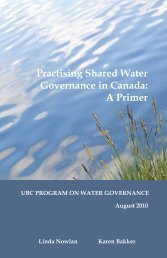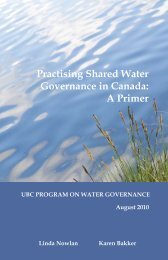Water Security Status Indicators - Program on Water Governance
Water Security Status Indicators - Program on Water Governance
Water Security Status Indicators - Program on Water Governance
Create successful ePaper yourself
Turn your PDF publications into a flip-book with our unique Google optimized e-Paper software.
WATER SECURITY GUIDANCE DOCUMENT<br />
PART 2 SECTION 4<br />
WATER SECURITY STATUS INDICATORS (WSSI)<br />
Figure 2. Geospatial Assessment Map for <str<strong>on</strong>g>Water</str<strong>on</strong>g> Quality in Township of Langley<br />
(refer to Part II, Secti<strong>on</strong> 5)<br />
Data Sources: ToL 2009, British Columbia Ministry of the Envir<strong>on</strong>ment (2011)<br />
The WQI results ranged from “good” to “poor”, with the majority (60 percent)<br />
indicating “fair” or “marginal” water quality. This diversity of water quality<br />
is unsurprising given the variety of aquifers in the ToL (c<strong>on</strong>fined and unc<strong>on</strong>fined<br />
with different sediment types and variable chemical c<strong>on</strong>stituents). Each<br />
of these aquifers may have a unique sensitivity to natural and anthropogenic<br />
c<strong>on</strong>taminants, which is a result of the complex hydrogeology of the ToL.<br />
To assess water quality for aquatic ecosystem health, the CCME WQI was<br />
applied again, this time using surface water data, and parameters and objectives<br />
specific to aquatic ecosystem health. Finding ‘objectives’ for parameters<br />
to assess aquatic ecosystem health was harder than for human health.<br />
Surface water (stream) data for Bertrand Creek (a representative creek in the<br />
ToL) were extracted from the provincial EMS database. Data availability was<br />
a significant issue. Of the two sampling sites in Bertrand Creek, <strong>on</strong>ly <strong>on</strong>e site<br />
had sufficient data for CCME WQI to be calculated. Another significant issue<br />
was the time period of the sampling. Ideally, WQI data should cover at least<br />
<strong>on</strong>e year; however, the data for sites were collected weekly over a <strong>on</strong>e-m<strong>on</strong>th<br />
time period, which does not enable seas<strong>on</strong>al variati<strong>on</strong> analysis. The parameters<br />
assessed were also selected based <strong>on</strong> data availability. Objectives were<br />
selected from either the CCME’s <str<strong>on</strong>g>Water</str<strong>on</strong>g> Quality Guidelines for the Protecti<strong>on</strong><br />
of Aquatic Health; Envir<strong>on</strong>ment Canada’s Freshwater Quality Index ecosystem<br />
health parameters; or from provincial guidelines (Envir<strong>on</strong>ment Canada<br />
2010b).<br />
In additi<strong>on</strong> to applying the WQI, we also identified the number of “critical<br />
streams” within the boundaries of ToL and number of known endangered<br />
fish species. Compromised riparian habitat and a reduced flow are causing<br />
c<strong>on</strong>diti<strong>on</strong>s of hypoxia in several streams in the regi<strong>on</strong> and impacting fish pop-<br />
17







